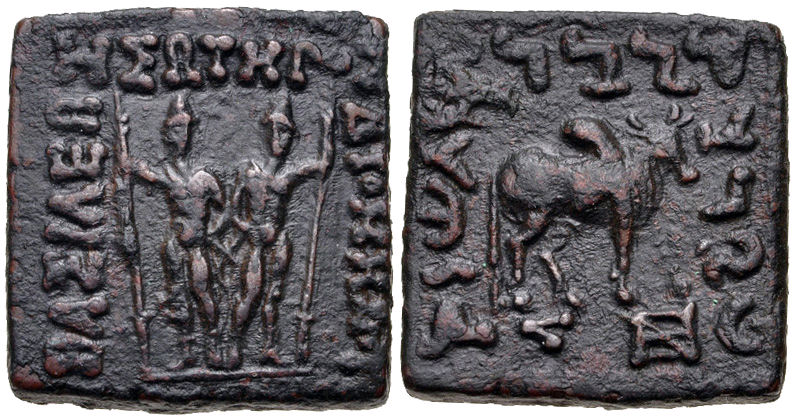Diomedes Soter on:
[Wikipedia]
[Google]
[Amazon]
 Diomedes Soter or Diodotus (
Diomedes Soter or Diodotus (
Coins of DiomedesOther coins of Diomedes
*
Le roi Diomède
{{DEFAULTSORT:Diomedes Soter Indo-Greek kings 1st-century BC rulers in Asia Diodotid dynasty
 Diomedes Soter or Diodotus (
Diomedes Soter or Diodotus (Greek
Greek may refer to:
Greece
Anything of, from, or related to Greece, a country in Southern Europe:
*Greeks, an ethnic group.
*Greek language, a branch of the Indo-European language family.
**Proto-Greek language, the assumed last common ancestor ...
: ; epithet means "the Saviour") was an Indo-Greek
The Indo-Greek Kingdom, or Graeco-Indian Kingdom, also known historically as the Yavana Kingdom (Yavanarajya), was a Hellenistic-era Greek kingdom covering various parts of Afghanistan and the northwestern regions of the Indian subcontinent ( ...
king and possible claimant Greco-Bactrian
The Bactrian Kingdom, known to historians as the Greco-Bactrian Kingdom or simply Greco-Bactria, was a Hellenistic-era Greek state, and along with the Indo-Greek Kingdom, the easternmost part of the Hellenistic world in Central Asia and the India ...
King who may have attempted to reconquer the lands north of the Hindu Kush
The Hindu Kush is an mountain range in Central and South Asia to the west of the Himalayas. It stretches from central and western Afghanistan, Quote: "The Hindu Kush mountains run along the Afghan border with the North-West Frontier Province ...
. The places where his coins have been found seem to indicate that his rule was based in the area of the Paropamisadae
Paropamisadae or Parapamisadae (Greek: Παροπαμισάδαι) was a satrapy of the Alexandrian Empire in modern Afghanistan and Pakistan, which largely coincided with the Achaemenid province of Parupraesanna. It consisted of the districts ...
, possibly with temporary dominions further east. Judging from their similar portraits and many overlapping monograms, the young Diomedes seems to have been the heir (and probably a relative) of Philoxenus, the last king to rule before the kingdom of Menander I
Menander I Soter ( grc, Μένανδρος Σωτήρ, Ménandros Sōtḗr, Menander the Saviour; pi, मिलिन्दो, Milinda), was a Greco-Bactrian and later Indo-Greek King (reigned c.165/155Bopearachchi (1998) and (1991), respectivel ...
finally fragmented.
Time of reign
Bopearachchi dates Diomedes to c. 95–90 BCE and R. C. Senior dates him to c. 115–105 BCE.Coins of Diomedes (Diodotus)
Diomedes either born Diodotus or reigning as such; perhaps erroneously labelled on legend as Diomedes, is depicted with theDioscuri
Castor; grc, Κάστωρ, Kástōr, beaver. and Pollux. (or Polydeukes). are twin half-brothers in Greek and Roman mythology, known together as the Dioscuri.; grc, Διόσκουροι, Dióskouroi, sons of Zeus, links=no, from ''Dîos'' ( ...
on his coins, either on horseback or standing; both types were previously used by Eucratides the Great, which strongly suggests a likt to the Diodotid dynasty,and further supports the subject of his mistaken name. It is however uncertain how the two were related, since Eucratides I died long before Diomedes.
Diomedes minted both Attic-type coins (Greco-Bactrian
The Bactrian Kingdom, known to historians as the Greco-Bactrian Kingdom or simply Greco-Bactria, was a Hellenistic-era Greek state, and along with the Indo-Greek Kingdom, the easternmost part of the Hellenistic world in Central Asia and the India ...
style, with Greek legend only), and bilingual coins (with Greek and Kharoshthi
The Kharoṣṭhī script, also spelled Kharoshthi (Kharosthi: ), was an ancient Indo-Iranian script used by various Aryan peoples in north-western regions of the Indian subcontinent, more precisely around present-day northern Pakistan and e ...
), indicating that he was ruling in the western part of the Indo-Greek territory.
One overstrike is known, of a coin of Strato and Agathokleia over a coin of Diomedes.Bopearachchi, ''De l'Indus à l'Oxus'', p. 129 This overstrike could indicate that Diomedes fought over the central areas of the Indo-Greek territories with Strato and Agathokleia.
See also
* Greco-Bactrian Kingdom *Greco-Buddhism
Greco-Buddhism, or Graeco-Buddhism, is the cultural syncretism between Hellenistic culture and Buddhism, which developed between the fourth century BC and the fifth century AD in Gandhara, in present-day north-western Pakistan and parts of nort ...
*Indo-Parthian Kingdom
The Indo-Parthian Kingdom was a Parthian kingdom founded by Gondophares, and active from 19 CE to c. 226 CE. At their zenith, they ruled an area covering parts of eastern Iran, various parts of Afghanistan and the northwest regions of the Indian s ...
*Indo-Scythians
Indo-Scythians (also called Indo-Sakas) were a group of nomadic Iranian peoples of Scythian origin who migrated from Central Asia southward into modern day Pakistan and Northwestern India from the middle of the 2nd century BCE to the 4th centu ...
* Kushan Empire
* Seleucid Empire
References
External links
Coins of Diomedes
*
Le roi Diomède
{{DEFAULTSORT:Diomedes Soter Indo-Greek kings 1st-century BC rulers in Asia Diodotid dynasty